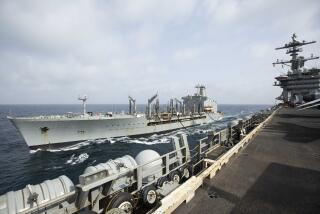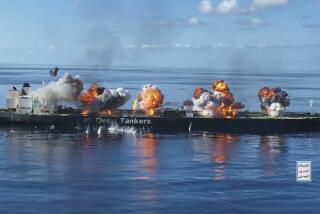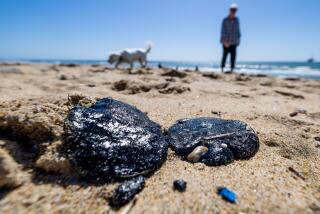Workers Attacking Oil Before It Reaches Texas : Spill: Officials say the fire aboard the Norwegian tanker in the Gulf of Mexico is out and the ship is stable. But the slick looms 13 miles offshore.
GALVESTON, Tex. — With the once-raging fire aboard the tanker Mega Borg extinguished, efforts turned Saturday to protecting Texas beaches from the remnants of 4.6-million gallons of crude oil spilled from the crippled tanker.
Coast Guard officials at a briefing said the fire that once engulfed the stern of the tanker and created a 1,500-foot-long stream of burning oil on the surface of the Gulf of Mexico was smothered late Friday by a final application of chemical foam.
“The situation right now offshore (on the tanker) is stable,” Lt. Cmdr. Frank Whipple said Saturday afternoon. “The fire is officially out.”
Salvage crews said a crude oil leak from one of the 853-foot tanker’s storage compartments had dwindled to virtually nothing.
Whipple said the latest estimate of the spill was 4.6-million gallons, although only 12,000 to 40,000 gallons were believed still to be in the water, the rest having either burned, evaporated or been eaten by experimental microbes.
Researchers planned a second experiment Saturday to gauge the effectiveness of bacteria on an oil spill at sea after the first test went awry and yielded no data, according to scientists circling the vicinity of the vessel.
In an attempt to test whether the microbes would digest the oil and turn it into harmless byproducts, the bacteria were sprayed Friday onto part of the oil slick by University of Texas oceanographer Carl Oppenheimer, who had collected the creatures from dozens of oily locales worldwide.
But the portion of the oil slick that was sprayed was not marked by a buoy or enclosed with floating booms. “Right now, the probability of determining whether the bacteria had any effect is zero,” said Terry Wade, chief scientist with the Geochemical and Environmental Group at Texas A&M;, who was aboard a research vessel.
The leading edge of an oil sheen moved Saturday to within 13 miles of Galveston Island and thousands of vacationers playing in the sun and surf. Prevailing currents, however, moved the oil parallel to the coast and not even tar balls were expected to hit land before today or Monday, if then.
“We’re concentrating on hitting the oil while it’s offshore,” Lt. Cmdr. Whipple said.
Five oil skimmers were working the closest sheen, trying to scoop up whatever dense oil there might be. Other skimmers worked on widely scattered patches of oil and sheens farther offshore.
Dr. Edward Klima of the National Oceanic and Atmospheric Administration said aerial sweeps have been made to monitor the impact on fish and other marine life, particularly dolphins and loggerhead turtles. He said three dirtied loggerhead turtles were captured and would be treated and released.
“The dolphins appear to be behaving in a normal manner, but they did move away from the oil,” he said. “Our concern is they tend to eat tar balls, and if they continue to do that, they die.”
With the chances dropping for the tanker to spill the rest of its cargo, residents on shore began to relax.
“We can breathe something of a sigh of relief now that the fire is out,” said Buck Wynne of the Texas Water Commission. “But the ship is still full of oil, so we can’t breathe too easily.”
The maritime drama began late June 8, when an explosion ripped through the engine room of the tanker. A fleet of boats and other craft fought the spectacular fire and finally gained the upper hand last Friday.
More to Read
Sign up for Essential California
The most important California stories and recommendations in your inbox every morning.
You may occasionally receive promotional content from the Los Angeles Times.










